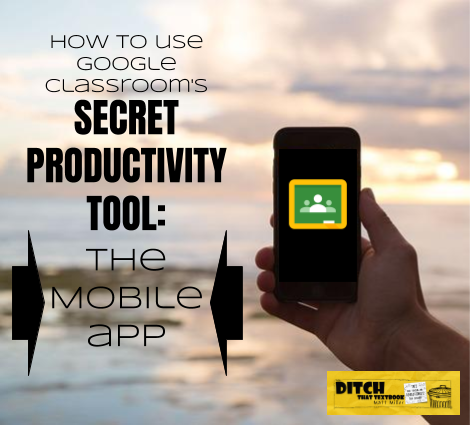
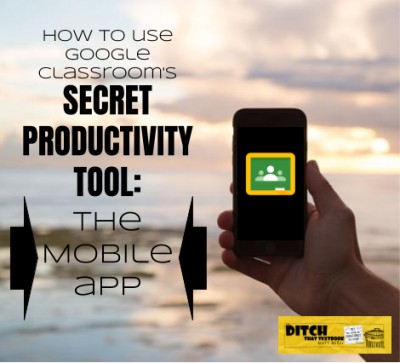
Google Classroom’s mobile app isn’t just for students. It can be a powerful productivity tool in your pocket as a teacher. (Public domain image via Pixabay.com)
The education world is starting to get used to Google Classroom.
It was released in August 2014 to much fanfare and basic features. Since then, the updates have come fast and furious, and as of January 2017, Google Classroom has more than 70 million users: students, teachers and others.
We’re finding ways to become more efficient and effective with Google Classroom.
We’re using notifications to manage Google Classroom like a boss.
But there’s still one super powerful Google Classroom tool that I don’t hear enough teachers talking about.
The mobile app.
“But we have Chromebooks/MacBooks/laptops/etc. … I don’t really need the mobile app.”
Think again. It’s a time-saving productivity dream in your pocket. Singlehandedly, it can help you handle questions that can be answered in seconds that would delay student work by days.
And when we talk about saving time, we’re probably speaking your language. Whenever I work with teachers, they always say their biggest barrier to doing the great things they envision is time.
Here are the top things you need to know to use Google Classroom’s mobile app like a ninja.
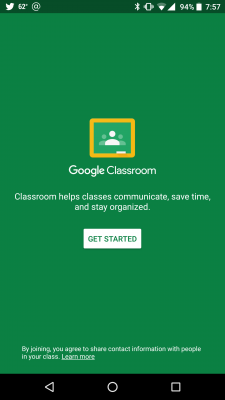
This is the screen that meets you when you install the Google Classroom app for the first time. (Google Classroom screenshot on Android app)
Let’s get that app added to your phone or tablet. It’s available on iTunes (iPhone/iPad) and on Google Play (Android devices).
When the app starts up, use the “Get Started” button and then choose the Google account that you use for Google Classroom.
You can always use the menu button (three lines) in the top left to change accounts if you need to.
This is where using the Google Classroom app can be a game-changer. Push notifications are those little messages that pop up at the top of the screen on your device. With Google Classroom, they can also come with a sound and a vibration (or you can turn those off).
The Classroom app has been updated to give you TONS of control over your notifications.
Just tap the menu button (three lines) and go to “Settings.” You’ll find that most of the settings screen is, in fact, notifications. You can turn on only the ones you want to get and shut off the ones that don’t matter.
Benefit: Your phone won’t be dinging and buzzing non-stop with stuff that doesn’t matter that much to you. (At least from the Google Classroom app … if it’s dinging and buzzing non-stop, you may want to do this with other apps too!)
Notifications you can enable or disable:
There are lots of options if you’re enrolled in a class, too, which are great for students AND for teachers who use Google Classroom for professional development.
NOTE: In the list above, it says “comments that mention you (with your email address)”. Did you know … you can add someone to a conversation in a Google file (doc, slide presentation, etc.) and send them a notification? In the comment, type the “+” sign right in front of his/her email address. (Example: +matt@ditchthatttextbook.com … but don’t send me a million notifications just to test it out, OK? 🙂 ) This is GREAT when students want to draw your attention to something specific in a file.
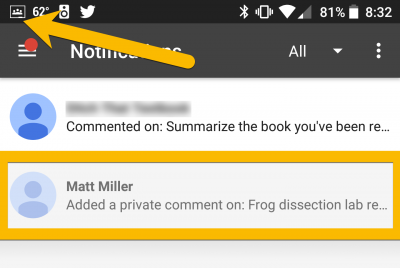
Notifications appear in your notification bar at the top. Tap the notification to see the student comment. (Google Classroom screenshot on Android app)
Private comments are a student’s direct line to you and answers to their questions. Class comments are an open forum for each assignment/announcement that everyone can see.
This could be the highest impact feature of the Google Classroom app.
After you’ve created an assignment, you and your students can send each other private comments back and forth within the assignment. You can also answer questions and make comments that everyone can benefit from in a class comment that everyone can see.
When a comment comes in, you’ll get a push notification (see yellow arrow in image to right). Tap on it to bring up your notifications, and tap on the notification for the private comment.
NINJA TIP: When you respond to a comment in Google Classroom, put your first and last initial at the beginning of the comment (mine are “MM”). When you’re looking at all of your notifications, they won’t say who made the comment. If you add your initials to the beginning of every comment you make, you’ll be able to easily see which ones you’ve responded to. (Thanks Alice Keeler … see her blog post for more detail!)
Think of it …
This may sound great — questions that may have waited until the next day get answered right away, getting students back on task and/or avoiding conflict/stress with parents about assignments.
However, this may not sound great to you — notifications may make you think that you’re going to be tethered to your students at all hours of the day with this digital leash.
Don’t worry, though. You get to pick when and how you get those notifications.
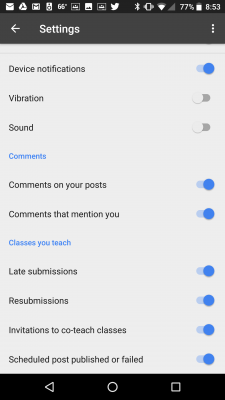
Turn your notifications on and off quickly here: Menu button (three lines) > Settings. (Google Classroom screenshot on Android app)
Instant access to you is a great benefit to your students.
However, when left unbridled, it can get in the way of your personal and family relationships, and it can make turning off teacher mode really tough.
(But let’s be honest … when do we really turn off teacher mode completely anyway?!?)
Let’s learn how to set some boundaries so we’re not answering questions about the format of frog dissection labs at 2 a.m.
It’s easy to turn off Classroom notifications completely on your mobile device — or to make them quieter or more inconspicuous.
Before you turn them off, it’s probably a good idea to let students know when you’ll be “on call” through Google Classroom. Let them know if you’ll be available …
… or any combination of those.
To turn off notifications on Google Classroom …
In three clicks, your notifications are turned off. You can probably do that in the matter of 15 seconds or less!
Just remember to turn them back on! Some ideas for remembering that:
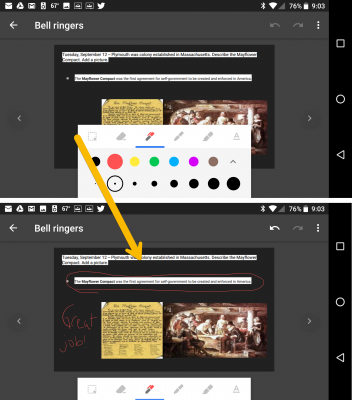
Draw on student work to give feedback. Then return it to the student for him/her to view. (Google Classroom screenshot on Android app)
If you do a lot of assigning in Google Classroom, do you miss the days when you could just jot comments in the margins of student work with your pen?
Those days are back, and you have your mobile app to thank!
Using your phone or a tablet, you can open up student work and draw on it with your finger (or a stylus).
Open the student file. Then click the pencil icon. You’ll open up your tray of tools: a fine-point pen, a wide-point marker, a highlighter, a text tool, an eraser and a selection tool.
Circle what needs changed. Write encouraging comments with your finger — or type it with text. Highlight an especially well-written passage.
When you’re done, Google Classroom will save your annotations as a PDF file and will return it to the student. (Note: It won’t actually change the student’s file … it will create a new file with your changes that he/she can view.)
This might be easiest if you have a PDF or a phone with a big screen. The bigger the screen, the easier it’s going to be to annotate student work.
There’s a lot, including:
Now that you know lots of the great features of the Classroom mobile app, here’s what you can do next:
For notifications of new Ditch That Textbook content and helpful links:
Interested in having Matt present at your event or school? Contact him by e-mail!
Matt is scheduled to present at the following upcoming events:
[getnoticed-event-table scope=”upcoming” max=”15″ expanding=”false”]

Session expired
Please log in again. The login page will open in a new tab. After logging in you can close it and return to this page.
Awesome this is great wonderful information.. Thanks.
perfect!!! Now I try to my mobile
I can’t see the list of comments on my phone like I did in May.
Jen.. Maybe..Maybe check the updates of GC because some changes may happend for improvement.. my opinion jen ssorry
I love the Google Classroom app SO MUCH! I use it all the time, and it works great!! Thanks! 🙂